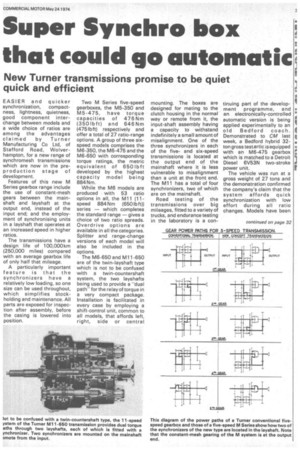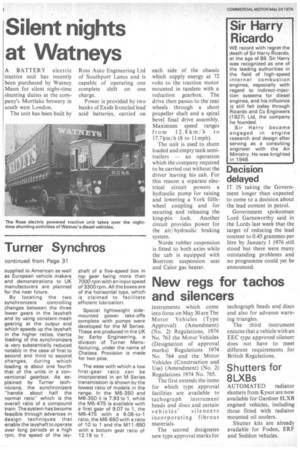Super Synchro box that could go automatic
Page 33

Page 34

If you've noticed an error in this article please click here to report it so we can fix it.
New Turner transmissions promise to be quiet quick and efficient
EASIER and quicker synchronization, compact ness, lightness, quietness, good component interchange between models and a wide choice of ratios are among the advantages claimed by Turner Manufacturing Co Ltd, of Stafford Road, Wolverhampton, for a new range of synchromesh transmissions which are now in the preproduction stage of development.
Features of this new M Series gearbox range include the use of constant-mesh gears between the mainshaft and layshaft at the output end, instead of the input end; and the employment of synchronising units in a layshaft that operates at an increased speed in higher ratios.
The transmissions have a design life of 100,000km (250,000 miles) compared with an average gearbox life of only half that mileage.
A particularly important feature is that the synchronizers have a relatively low loading, so one size can be used throughout, which simplifies stockholding and maintenance. All parts are exposed for inspection after assembly, before the casing is lowered into position. Two M Series five-speed gearboxes, the M5-350 and M5-475, have torque capacities of 476 Nm (350 lbft) and 646 Nm (475 lbft) respectively and offer a total of 27 ratio-range options. A group of three sixspeed models comprises the M6-350, the M6-475 and the M6-650 with corresponding torque ratings, the metric equivalent of 6501blt developed by the highest capacity model being 884 Nm.
While the M6 models are produced with 53 ratio options in all, the M11 (11speed 884 Nm (6501b ft)) series — which completes the standard range — gives a choice of two ratio spreads. Overdrive options are available in all the categories. Splitter and range-change versions of each model will also be included in the options.
The M6-650 and M11-650 are of the twin-layshaft type which is not to be confused with a twin-countershaft system, the two layshafts being used to provide a "dual path" for the relay of torque in a very compact package. Installation is facilitated in every case by employing a shift-control unit, common to all models, that affords left, right, side or central mounting. The boxes are designed for mating to the clutch housing in the normal way or remote from it, the input-shaft assembly having a capacity to withstand indefinitely a small amount of misalignment. One of the three synchronizers in each of the fiveand six-speed transmissions is located at the output end of the mainshaft where it is less vulnerable to misalignment than a unit at the front end. The M11 has a total of four synchronizers, two of which are on the mainshaft.
Road testing of the transmissions over big mileages, fitted to a variety of trucks, and endurance testing in the laboratory is a con
tinuing part of the development programme, and an electronically-controlled automatic version is being applied experimentally to an old Bedford coach. Demonstrated to CM last week, a Bedford hybrid 32ton gross testartic isequipped with an M6-475 gearbox which is matched to a Detroit Diesel 6V53N two-stroke power unit.
The vehicle was run at a gross weight of 27 tons and the demonstration confirmed the company's claim that the system affords quick synchronization with low effort during all ratio changes. Models have been supplied to American as well as European vehicle makers and demonstrations to UK manufacturers are planned for the near future.
By locating the two synchronizers controlling changes between the three lower gears in the layshaft and by using constant-mesh gearing at the output end which speeds up the layshaft in the higher ratios, inertia loading of the synchronizers is very substantially reduced notably in the case of first to second and third to second changes, during which loading is about one fourth that of the units in a conventional gearbox. As explained by Turner technicians, the synchronizers "handle about half the normal ratio" which is the overall ratio of a compound train. The system has become feasible through advances in design techniques that enable the layshaft to operate over long periods at a high rpm, the speed of the lay shaft of a five-speed box in top gear being more than 7000 rpm with an input speed of 3300 rpm. All the boxes are of the horixontal type, which is claimed to facilitate efficient lubrication.
Special lightweight sidemounted power take-offs complete with pumps were developed for the M Series. These are produced in the UK by Earby Engineering, a division of Turner Manufacturing, under the name of Chelsea. Provision is made for two ptos.
The ease with which a low first-gear ratio can be incorporated in an M Series transmission is shown by the lowest ratio of models in the range. In the M5-350 and M6-350 it is 7.93 to 1, while the M5-475 is available with a first gear of 9.07 to 1, the M6-475 with a 9.08-to-1 ratio, the M6-650 with a ratio of 10 to 1 and the M11-650 with a bottom gear ratio of 12.19 to 1.




































































































































